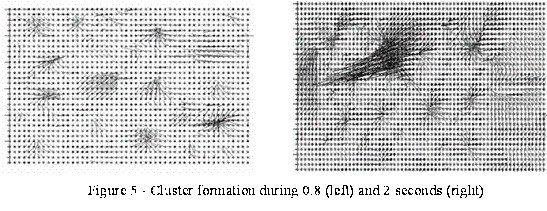
|
KINETICS OF PHASES INTERACTION DURING MINERAL PROCESSING SIMULATION
Nazimko E., Corchevsky A., Druts I.
Donetsk National Technical University
Источник: Proceedings of XV International Congress of Coal Preparation. China. – 2006. – pр. 775-781.
Mineral processing involves particles and phases interaction. A numerical model has been developed which is based on particles interaction. Comparison of the results of computer simulation with experimental data demonstrated reasonable convergence. Fluctuations of tangential velocity of the particle during its sliding along the bubble surface have been discovered. This model was applied for coal dewatering and for dry separation modeling.
Introduction
The interaction of phases is the basis of majority of technologies for mineral processing. Typical examples are interaction of air bubbles with reagents and minerals during their flotation, mineral-water interfaces in dewatering of fine coal, etc. These interactions are very hard to investigate because they are dynamical, impacted by long array of physical and chemical factors and occur in a small scale. The mentioned above processes have been traditionally studied by laboratory experiments. These tests are tedious and time consuming, although indicate unsatisfactory accuracy. Analytical investigations yield idealized results. One of the powerful alternatives to deal with the problem is a numerical simulation which combines dynamics, accuracy and consideration of sophisticated details. This model is based on discrete elements. In this paper a computer model for simulation of kinetics of phase’s interaction during mineral processing will be considered.
Validation of the model
We have made a set of computer simulations to accumulate sufficiently versatile data. The next computer experiments have been accomplished: air bubble take-off from a mineralized plate has been investigated for different inclination of the plate relatively horizon; time of coal particle residence on an air bubble was investigated for different boundary and initial conditions; trajectory, velocity and acceleration of a mineral particle have been registered during its impact with an air bubble at different eccentricity.
Simulation of coal slime vacuum filtration
Process of dewatering of fine coal slime is governed by several hydrodynamics laws and is evolutionary by nature. At the first stage, concentration of solid particles in the slime is low and water moves among the particles free because the sediment has not been formed and there are not channels that conduct the water [7]. Then the coarse particles trap at the filter fabric and fine particle accumulate over the coarse. The sediment gradually forms and increases its hydraulic resistance. Actually this sediment experiences complex evolution. This process has been simulated with above described code.
This model is adapted to simulate stochastic distribution of the particles by probabilistic variation of their sizes. Friction factors, viscosity resistance and the other parameters of the computer model were adopted to mimic physic and reologic properties of the coal fine slurry that sediments at the filter fabric.
During simulation of sediment compaction and thickening, coordinates of the particles have been recalculated and monitored through space in time. These data had been treated by special computer program that separated vector field of particle movement into clusters. There were four groups of the clusters, those moved to the right upward, to the right downward, left upward and downward (Figure 5). Analysis of the results of simulation has demonstrated that the channels change their form during sedimentation and compaction of the solid phase.

Individual points in the Figure 5 correspond to groups of the particles that imitate the liquid. Vectors represent incremental displacement of the particles. The most interesting from practical point of view are downward vectors because they coincide with direction of filtration. The frames left and right in the Figure 5 indicates that liquid clusters redistribute over time. The clusters origin, collide and disappear due to progress of filtration and sedimentation process. As a result, some portions of the water shift direction of the movement from right to left and vise versa and even from downward to upward. This fluctuation produced impediment and trapping of the liquid that reduces rate of filtration. Due to reshaping of cluster mosaic the traps may be eventually destroyed that frees the water. Hence the channels change the permeability during sedimentation and compaction of solid.
This simulation has demonstrated that the liquid filtrates by turn in space and in time. When the water moves at a certain area, it may be impeded at adjacent area. However this situation may be eventually triggered due to cluster evolution of the sediment and its interaction with hydraulic pressure gradient. Simulation indicated that dynamic shear of the sediment is effective mean to maintain rate of filtration because tangential strain of the sediment destroys the deadlocks and traps.
References
1. Cundall, P.A., Strack, O.D.L. A discrete numerical model for grannular assemblies. Geotechnique. – vol. 29, no.1. – 1979. – pp. 47–65.
2. Bathurst, R.J., Rothenburg, L. Observations on stress-force-fabric relationships in idealized grannular media. Mech. of Mat., vol. 9. – 1990. – pp. 65–80.
3. Bruno, M. S. et al. Some influences of saturation and fluid flow on sand production: Laboratory and Discrete Element Model Investigations. SPE 36534. Proceedings 1996 SPE Ann. Tech. Conf., Denver, Colorado, 6–9 October. – 1996. – pp. 447–461.
4. Garkovenko E.E. et al. Features of fine coal materials flotation and dewatering. Donetsk. – 2002. – 266 p. Russian text.
5. Emelyanov D. S. Coal flotation basics. Kharkov University. Kharkov. – 1958. – 216 p. Russian text.
6. Whelan, P. F., Brown, D. J. Particle-Bubble Attachment in Froth Flotation. Bull. Inst. Min. a. Met., No 591, 593 (1956).
7. Jujikov V.A.. Filtration. Theory and practice of suspensions separation. Moscow. Chemistry. – 1980. – 398p. Russian text.
Назад
|